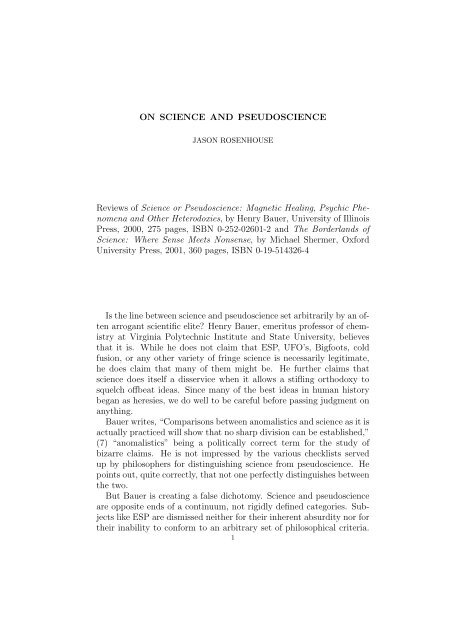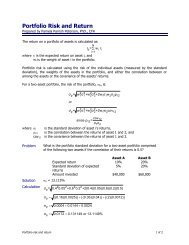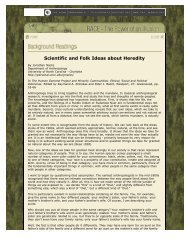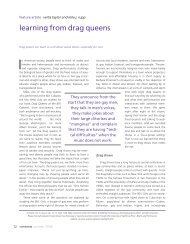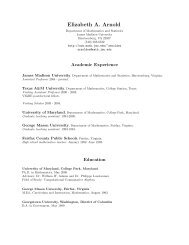ON SCIENCE AND PSEUDOSCIENCE Reviews of ... - it-educ.jmu.edu
ON SCIENCE AND PSEUDOSCIENCE Reviews of ... - it-educ.jmu.edu
ON SCIENCE AND PSEUDOSCIENCE Reviews of ... - it-educ.jmu.edu
You also want an ePaper? Increase the reach of your titles
YUMPU automatically turns print PDFs into web optimized ePapers that Google loves.
<strong>ON</strong> <strong>SCIENCE</strong> <strong>AND</strong> PSEUDO<strong>SCIENCE</strong><br />
JAS<strong>ON</strong> ROSENHOUSE<br />
<strong>Reviews</strong> <strong>of</strong> Science or Pseudoscience: Magnetic Healing, Psychic Phenomena<br />
and Other Heterodoxies, by Henry Bauer, Univers<strong>it</strong>y <strong>of</strong> Illinois<br />
Press, 2000, 275 pages, ISBN 0-252-02601-2 and The Borderlands <strong>of</strong><br />
Science: Where Sense Meets Nonsense, by Michael Shermer, Oxford<br />
Univers<strong>it</strong>y Press, 2001, 360 pages, ISBN 0-19-514326-4<br />
Is the line between science and pseudoscience set arb<strong>it</strong>rarily by an <strong>of</strong>ten<br />
arrogant scientific el<strong>it</strong>e? Henry Bauer, emer<strong>it</strong>us pr<strong>of</strong>essor <strong>of</strong> chemistry<br />
at Virginia Polytechnic Inst<strong>it</strong>ute and State Univers<strong>it</strong>y, believes<br />
that <strong>it</strong> is. While he does not claim that ESP, UFO’s, Bigfoots, cold<br />
fusion, or any other variety <strong>of</strong> fringe science is necessarily leg<strong>it</strong>imate,<br />
he does claim that many <strong>of</strong> them might be. He further claims that<br />
science does <strong>it</strong>self a disservice when <strong>it</strong> allows a stifling orthodoxy to<br />
squelch <strong>of</strong>fbeat ideas. Since many <strong>of</strong> the best ideas in human history<br />
began as heresies, we do well to be careful before passing judgment on<br />
anything.<br />
Bauer wr<strong>it</strong>es, “Comparisons between anomalistics and science as <strong>it</strong> is<br />
actually practiced will show that no sharp division can be established,”<br />
(7) “anomalistics” being a pol<strong>it</strong>ically correct term for the study <strong>of</strong><br />
bizarre claims. He is not impressed by the various checklists served<br />
up by philosophers for distinguishing science from pseudoscience. He<br />
points out, qu<strong>it</strong>e correctly, that not one perfectly distinguishes between<br />
the two.<br />
But Bauer is creating a false dichotomy. Science and pseudoscience<br />
are oppos<strong>it</strong>e ends <strong>of</strong> a continuum, not rigidly defined categories. Subjects<br />
like ESP are dismissed ne<strong>it</strong>her for their inherent absurd<strong>it</strong>y nor for<br />
their inabil<strong>it</strong>y to conform to an arb<strong>it</strong>rary set <strong>of</strong> philosophical cr<strong>it</strong>eria.<br />
1
2 JAS<strong>ON</strong> ROSENHOUSE<br />
They are dismissed because they have never manifested themselves under<br />
properly controlled cond<strong>it</strong>ions. Confronted w<strong>it</strong>h this obvious fact<br />
Bauer can only reply w<strong>it</strong>h cliches.<br />
Maybe the presence <strong>of</strong> skeptics kills the vibe necessary for ESP to<br />
manifest <strong>it</strong>self. The numerous eye-w<strong>it</strong>ness accounts <strong>of</strong> paranormal activ<strong>it</strong>y<br />
should be considered viable evidence. The experts have been<br />
wrong before. The unexplained residue <strong>of</strong> cases that have not been<br />
debunked strongly suggest the real<strong>it</strong>y <strong>of</strong> the paranormal.<br />
These are all fine points if your goal is to defend the logical viabil<strong>it</strong>y <strong>of</strong><br />
various anomalous claims. But as arguments for rethinking the nature<br />
<strong>of</strong> science they fall flat. Since even the most hardened skeptic would<br />
not deny the possible valid<strong>it</strong>y <strong>of</strong> paranormal phenomena, <strong>it</strong> seems that<br />
Bauer is defending the obvious.<br />
Arrayed against his eminently sensible pos<strong>it</strong>ion, Bauer sees a shadowy<br />
troika made up <strong>of</strong> “debunkers,” “skeptics,” and “science groupies.”<br />
These groups are never defined, nor is a single example <strong>of</strong> unfair activ<strong>it</strong>ies<br />
on their part c<strong>it</strong>ed. We are nonetheless deluged w<strong>it</strong>h comments like<br />
this one: “Skeptics suggest that converting others to their own opinion<br />
is the same as <strong><strong>edu</strong>c</strong>ating them, or that convincing others to disbelieve<br />
is the same as helping others to become skeptical.”(71) Elsewhere on<br />
the same page we are told debunkers dismiss claims <strong>of</strong> dowsing or parapsychology<br />
based on a single test, but no example is given <strong>of</strong> anyone<br />
making such a claim.<br />
Indeed, debunking is nothing more than asking for evidence <strong>of</strong> paranormal<br />
phenomena under cond<strong>it</strong>ions that preclude trickery. If Bauer<br />
were serious about raising the respectabil<strong>it</strong>y <strong>of</strong> anomalous claims, he<br />
would welcome rather than denigrate the activ<strong>it</strong>ies <strong>of</strong> people like James<br />
Randi and groups like the CSICOP.<br />
When Bauer is not slinging mud at his favor<strong>it</strong>e straw men, he is<br />
expressing astonishment at the v<strong>it</strong>uperation hurled at people like Immanuel<br />
Velikovsky. He wr<strong>it</strong>es, “He was wrong in many ways, but he<br />
was not a fraud or deliberate charlatan. He wasn’t peddling snake oil or<br />
disingenuous tax cuts.” (156) When a man bypasses the informed cr<strong>it</strong>icism<br />
<strong>of</strong> his colleagues, and presents his ideas in a popular-level book<br />
claiming to be the latest word from science, I call <strong>it</strong> selling snake oil.<br />
On the other side <strong>of</strong> the coin, he points out that superconductiv<strong>it</strong>y was<br />
angrily dismissed when first proposed. Sure, and superconductiv<strong>it</strong>y<br />
earned <strong>it</strong>s acceptance by producing results replicable in any laboratory<br />
w<strong>it</strong>h the proper equipment. ESP and the rest will have to do likewise<br />
before becoming mainstream.<br />
People like Pons and Fleischmann, <strong>of</strong> cold fusion fame, are reviled<br />
because they refused to perform simple experiments that would have
<strong>ON</strong> <strong>SCIENCE</strong> <strong>AND</strong> PSEUDO<strong>SCIENCE</strong> 3<br />
resolved much <strong>of</strong> the controversy (see Robert Park’s Voodoo Science<br />
for a full account). By contrast, Stephen Jay Gould’s heterodox theories<br />
about evolution did not keep him from becoming one <strong>of</strong> the most<br />
honored scientists in the world. The difference between the two cases<br />
does not lie in philosophical abstractions, but in the way the principles<br />
conducted themselves. Pons and Fleischmann consistently avoided the<br />
leg<strong>it</strong>imate scrutiny <strong>of</strong> their peers, whereas Gould pos<strong>it</strong>ively reveled in<br />
the same.<br />
Bauer is up front about his fondness for Loch Ness monsters. I<br />
would suggest that <strong>it</strong> is this, and not any deep questions about proper<br />
scientific methodology, that motivates him. He is sore that mainstream<br />
science has dismissed many claims he feels to be leg<strong>it</strong>imate. Hence, this<br />
book. In lieu <strong>of</strong> original insights and strong arguments, <strong>it</strong> <strong>of</strong>fers only<br />
silly cliches, uncalled for snideness, and simplistic historical analyses.<br />
There is a further irony in Bauer’s book. Though he routinely complains<br />
that science needs to be more open to new ideas, his analysis<br />
is confined to the oldest topics in the annals <strong>of</strong> fringe science. ESP,<br />
UFO’s, and Bigfoots have been around for decades and have been the<br />
subject <strong>of</strong> much serious wr<strong>it</strong>ing. But what about the many contemporary<br />
examples <strong>of</strong> heretical views w<strong>it</strong>hin the pantheon <strong>of</strong> science?<br />
It is these far more interesting heresies that form the basis <strong>of</strong> Michael<br />
Shermer’s new book. In his role as President <strong>of</strong> the Skeptic’s Society,<br />
Shermer has investigated countless extraordinary claims. There is no<br />
one better qualified to assess the difference between science and pseudoscience.<br />
After a detailed introduction in which he recounts his investigation<br />
<strong>of</strong> a remote viewing outf<strong>it</strong> (and which, incidentally, provides a compelling<br />
counterexample to the dogmatic arrogance <strong>of</strong> skeptics portrayed<br />
by Bauer), Shermer <strong>of</strong>fers assessments <strong>of</strong> various branches <strong>of</strong> human<br />
knowledge seeking. On the science end <strong>of</strong> the continuum we find such<br />
subjects as quantum mechanics and evolution. On the pseudoscience<br />
side we find <strong>it</strong>ems like creationism, astrology and Bible codes. Rejecting<br />
a phony dichotomy between science and pseudoscience does not<br />
preclude us from distinguishing between those investigations that have<br />
consistently born fru<strong>it</strong> from those that have not.<br />
But the real action occurs in the center <strong>of</strong> the continuum. These<br />
are the borderlands in the t<strong>it</strong>le <strong>of</strong> the book. Here we find things like<br />
superstring theory and the SETI project. Shermer begins by analyzing<br />
several heterodox theories, such as the punctuated equilibrium model
4 JAS<strong>ON</strong> ROSENHOUSE<br />
<strong>of</strong> evolution <strong>of</strong>fered by Eldredge and Gould, and the relationship between<br />
race and athletic achievement. Particularly impressive is his<br />
discussion <strong>of</strong> human cloning. Shermer <strong>of</strong>fers a compelling alternative<br />
to the pompous sermonizing that has surrounded the issue ever since<br />
Dolly the sheep became big news in 1997.<br />
From here he turns to the history <strong>of</strong> science. By comparing the<br />
lives and experiences <strong>of</strong> scientists such as Freud, Darwin, Wallace and<br />
Sagan; people whose work straddled the line between orthodoxy and<br />
heresy; Shermer <strong>of</strong>fers fascinating insights into the genesis and acceptance<br />
<strong>of</strong> new ideas in science. He makes essential use <strong>of</strong> the theories<br />
<strong>of</strong>fered by social scientist Frank Sulloway in his book Born to Rebel,<br />
particularly Sulloway’s ideas relating birth order to openness to new<br />
ideas. Sulloway’s theories are themselves controversial, so Shermer’s<br />
approach may not be to everyone’s liking. But <strong>it</strong> certainly represents<br />
an original and valuable contribution to the study <strong>of</strong> the history <strong>of</strong><br />
science.<br />
The final section moves from specific people to specific events. Here<br />
we find discussions <strong>of</strong> the Piltdown hoax and the potential dispute<br />
(actually resolved peacefully) between Darwin and Wallace concerning<br />
the cred<strong>it</strong> for the discovery <strong>of</strong> evolution. While creationists routinely<br />
use both incidents as weapons in their ongoing struggle w<strong>it</strong>h modern<strong>it</strong>y,<br />
Shermer shows that they <strong>of</strong>fer much <strong>of</strong> which science can be proud. The<br />
Piltdown hoax, for example, illustrates the self-correcting nature <strong>of</strong> science.<br />
Piltdown was exposed not because clear-thinking nonscientists<br />
exposed the dogmatism <strong>of</strong> an arrogant el<strong>it</strong>e, but because paleontologists,<br />
on the basis <strong>of</strong> accumulated evidence, came to view the Piltdown<br />
fossils as a square peg in a round hole.<br />
Much <strong>of</strong> Shermer’s past wr<strong>it</strong>ing has involved exposing popularly held<br />
myths, and Borderlands is no exception. He argues that the vision<br />
<strong>of</strong> scientific progress that pos<strong>it</strong>s geniuses producing revolutions fullyformed<br />
in one moment <strong>of</strong> brilliant insight is one such myth. He backs<br />
this up w<strong>it</strong>h analyses <strong>of</strong> perennial favor<strong>it</strong>es such as Einstein and Newton,<br />
as well as less familiar cases such as mathematician Evariste Galois.<br />
He also dismisses the idea that prim<strong>it</strong>ive human civilizations lived<br />
in perfect harmony w<strong>it</strong>h their environments, unlike their more modern<br />
counterparts. These arguments are defended w<strong>it</strong>h impressive erud<strong>it</strong>ion,<br />
as Shermer discusses the relevant l<strong>it</strong>erature from history, anthropology,<br />
and evolutionary biology.<br />
Skeptical l<strong>it</strong>erature <strong>of</strong>ten consists <strong>of</strong> l<strong>it</strong>tle more than a compendium<br />
<strong>of</strong> stories lamenting the gullibil<strong>it</strong>y <strong>of</strong> the public. Shermer goes well<br />
beyond this tried-and-true formula and has produced a book chockfull<br />
<strong>of</strong> original insights and calm argumentation based on meticulously
<strong>ON</strong> <strong>SCIENCE</strong> <strong>AND</strong> PSEUDO<strong>SCIENCE</strong> 5<br />
collected evidence. He is fearless in tackling difficult and subtle issues<br />
w<strong>it</strong>h relentless common sense. The Borderlands <strong>of</strong> Science will reward<br />
careful study, and will doubtless provide fodder for discussion for a long<br />
time to come.<br />
This review was originally published in The Humanist, Vol. 61, No.<br />
5, September/October 2001, pp. 32-33.


